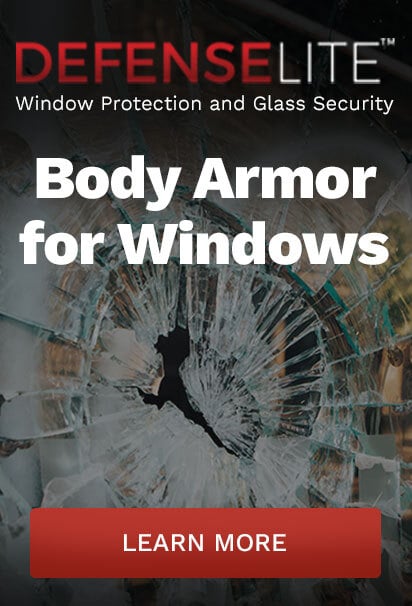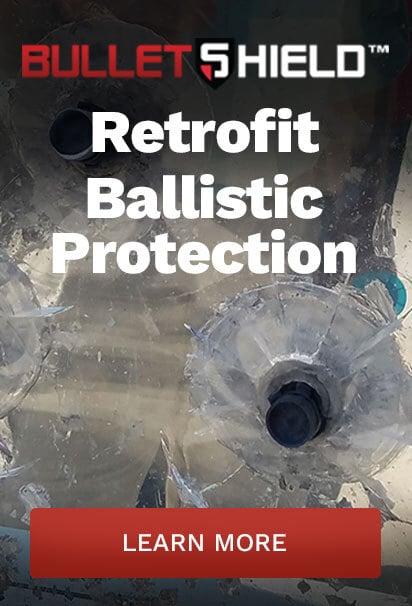Choosing the Right Retrofit Security Glazing

How forced-entry and ballistic glazing differ—and why polycarbonate delivers long-term performance.
Retrofit security glazing is now a core requirement for buildings facing higher threat levels. Retail stores, schools, churches, and public facilities continue to experience rising smash-and-grab incidents, coordinated burglary attempts, and civil unrest events.
These attacks place existing glass at risk because standard glazing cannot stop forced entry.
Glass or Polycarbonate? Choosing the Right Retrofit Security Glazing
Recent reports from AP News and NBC Los Angeles show how break-ins now use tools, speed, and coordinated tactics. These events highlight the need for stronger glazing that protects people and assets.
Retrofit security glazing offers a solution that raises protection without full window replacement. Architects, facility managers, and security consultants want clarity about the differences between material types. Many discussions also confuse acrylic and polycarbonate, even though they behave very differently under impact.
This article explains how forced-entry and ballistic standards differ and why polycarbonate provides the most reliable performance for retrofit forced-entry applications. The discussion also addresses long-term clarity, surface durability, and UV stability—common concerns for design teams.
Two Different Threats, Two Different Standards
Understanding the differences between threat types is essential when evaluating retrofit security glazing. Ballistic attacks and forced-entry attempts create very different forms of energy, tools, and damage.
These threats also follow unique testing protocols that measure performance in separate ways. Confusing these categories can lead to incorrect specifications and reduced protection.
Before reviewing material choices, it is important to outline how each threat is defined and why the standards behind them matter.
Ballistic Resistance
Ballistic protection focuses on stopping bullets. UL 752 and NIJ 0108.01 define this performance. Ballistic materials must prevent projectile penetration and limit spall, which is secondary fragmentation.
These systems use thick glass laminates or proprietary composites designed for stiffness and energy control. Ballistic resistance does not equal forced-entry resistance. Ballistic tests use firearms and fixed firing cycles.
Forced-entry tests use blunt tools, impact sequences, and timed breach attempts. Each test measures a different risk category.
Forced-Entry Resistance
Forced entry focuses on delaying a breach. ASTM F3038 is the long-standing standard for simulating active threats with tools.
ASTM F3561 is the newer test method for evaluating the forced-entry and active-threat performance of fenestration systems. Level 3 represents the highest rating under this method. Systems with this rating rely on timed attacks using tools such as hammers, pry bars, or heavy striking devices.
RiotLite 27 (RL 27) is a documented example of a film-based security system tested to ASTM F3561 Level 3. It supports at-risk retail environments and institutional glazing exposed to high-energy attacks.
These standards confirm one critical point. Ballistic systems resist bullets. Forced-entry systems delay intruders. They are not interchangeable and should never be specified as if they serve the same function.
Material Basics: Forced-Entry and Ballistic Glass Laminates vs. Polycarbonate
Selecting the right material is central to effective retrofit security glazing. Glass laminates, acrylic, and polycarbonate each respond to impact in distinct ways, directly influencing performance under forced-entry or ballistic threats.
Many design discussions treat these materials as interchangeable, yet their structural behavior, weight, clarity, and long-term durability vary widely. It is important to understand how these core materials compare and why their properties matter in real-world security applications.
Glass Laminates
Ballistic glazing relies on thick glass layers bonded by PVB or ionoplast interlayers. These laminates offer excellent stiffness and optical clarity but add weight. Heavy laminated units are difficult to install as retrofits in existing frames.
They also limit the deflection needed to absorb repeated impact. Laminated units perform well in ballistic applications but show less efficiency in flexible retrofit systems.
Acrylic (PMMA)
Acrylic provides good optical clarity and surface hardness. It resists UV exposure better than early polycarbonate grades.
Yet acrylic is brittle under heavy impact. It performs poorly under repeated blows from blunt tools, where cracking spreads quickly. Its impact strength is lower than polycarbonate, which limits its role in forced-entry situations.
These traits matter because many design teams assume acrylic and polycarbonate are similar. They are not. Acrylic fractures under load. Polycarbonate absorbs energy.
Polycarbonate (PC)
Polycarbonate sheets offer high ductility and superior impact resistance. It can deform under impact without cracking. This behavior allows it to absorb energy and delay intrusion. It is far lighter than laminated glass, making it ideal for retrofit frames. Early polycarbonate had issues with surface scratching.
Modern hard-coated, UV-stabilized grades, including the type utilized in DefenseLite® glazing systems, address these concerns. These sheets maintain optical clarity and resist damage from chemicals, abrasion, and weather.
Polycarbonate’s mechanical behavior explains why it performs well in demanding security applications. It flexes instead of shattering. It also integrates into engineered systems that “float” during impact, which protects the primary glass behind the panel.
Why Polycarbonate Excels in Forced-Entry Retrofits
Polycarbonate enables high-performance forced-entry retrofits because of its unique mechanical response. Its ductility lets it absorb repeated blows from hammers or bats. This action slows attackers and protects the primary glazing. It resists cracking even after heavy tool strikes.
Its light weight also simplifies installation. Retrofit units can be mounted over existing glazing with minimal frame modifications. These overglaze systems reduce cost, time, and disruption for active buildings.
Key advantages include:
- High energy absorption under repeated impact
- Resistance to cracking when struck with heavy tools
- Lighter weight than laminated glass
- Easier installation with existing frames
- Compatibility with flexible retrofit systems
Engineered systems, such as DefenseLite® PRO, use polycarbonate within flexible frames. These frames allow the panel to shift and deform under load. That movement disperses impact energy and prevents access. It also supports long-term durability because the frame carries a greater share of the load during extreme attacks.
The result is a retrofit security glazing system that improves safety without major construction.
Addressing Common Architect Concerns
Architects want to know how polycarbonate glazings will perform over time. Common questions involve yellowing, haze, and scratch resistance. Modern polycarbonate solves these issues with hard-coat surfaces, UV-blocking layers, and optional protective films—including the option to add anti-graffiti film.
Most high-quality polycarbonate sheets now resist yellowing and haze for more than seven years. Many products include warranties that extend fifteen years, depending on exposure and location.
Hard-coat technology also resists scratches and abrasion. These coatings stand up to daily use in high-traffic areas. They also enhance chemical resistance, which helps during cleaning.
Following maintenance instructions in specifications helps preserve long-term clarity and surface performance. Polycarbonate responds well to proper care, but the wrong cleaners or tools can damage hard-coat layers. Clear guidance reduces risk and helps facility teams protect the material over time.
Specifications should outline cleaning products, approved tools, and inspection procedures.
Recommended guidance often includes:
- Using non-ammonia cleaners that will not degrade hard-coat surfaces
- Applying mild soap solutions for routine washing
- Avoiding abrasive pads or brushes that can create micro-scratches
- Using soft microfiber cloths for drying and polishing
- Scheduling periodic inspections to check for surface wear or film damage
- Replacing sacrificial films when needed to maintain clarity
These steps support consistent performance and extend the life of the protective system. They also ensure the glazing continues to meet project expectations for visibility and durability throughout its service life.
Enhancing Performance with Films and Coatings
Enhancing the performance of retrofit security glazing often involves using specialized films and coatings. These products support clarity, durability, and long-term surface protection.
They also help manage UV exposure and reduce maintenance needs in high-traffic or high-risk locations. Films vary in purpose, so it is important to understand how each type functions and how they integrate with polycarbonate systems.
Before reviewing specific options, it helps to outline why these layers matter and how they contribute to overall system performance.
Anti-Graffiti Films
Anti-graffiti films act as sacrificial layers. They protect the surface from scratches, etching, or vandalism. They also block up to 99 percent of UV light. This reduces the UV load on the polycarbonate and supports long-term clarity. These films peel and replace after damage, which lowers maintenance costs.
UV-Control Films
UV-control films reduce ultraviolet exposure. They are helpful where glazing faces intense sunlight. Designers should confirm compatibility with the panel manufacturer because warranties vary.
Security Films vs. Surface Protection Films
Security films designed for forced-entry protection, such as RiotLite 27, are structurally engineered for impact resistance. Surface protection films focus on appearance and durability. They should not be treated as the same product category.
Each film type adds value, but only security films undergo ASTM F3561 testing.
Integrating Polycarbonate into Modern Security Strategies
Retrofit security glazing is now part of broader threat-reduction strategies. Many facilities want a non-invasive upgrade that protects entry doors, storefronts, and high-risk glass.
Polycarbonate supports these goals by delivering strong forced-entry resistance without structural modification.
Security consultants also use polycarbonate with forced-entry frames to create layered defenses. This approach delays intruders, buys response time, and reduces property loss.
Retailers use it to deter smash-and-grab attempts. Institutions rely on it to secure public access points.
Real-world events have proven the need for this layer of protection. Incidents involving coordinated burglary crews in Los Angeles show how speed and force can overwhelm standard glass. Polycarbonate retrofits help facilities prepare for similar threats.
Key Takeaways for Retrofit Security Glazing
Retrofit security glazing must address real-world threats such as forced entry, coordinated break-ins, and vandalism. Ballistic glazing protects against bullets. Forced-entry systems resist tool-based attacks. These requirements demand different materials, tests, and system designs.
Polycarbonate supports forced-entry retrofits because it absorbs energy, maintains clarity, and installs easily over existing glazing. Modern UV-stabilized and hard-coated grades prevent yellowing and haze. Protective films extend longevity and defend against damage.
Architects, facility managers, and security teams can integrate polycarbonate into engineered retrofit systems to deliver high performance without major construction. This approach improves safety, protects assets, and supports long-term building security.
To learn more about retrofit security glazing, or request a site assessment, contact the professionals at DefenseLite.


